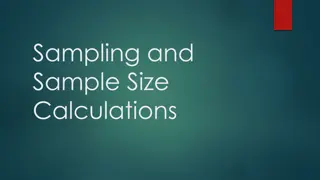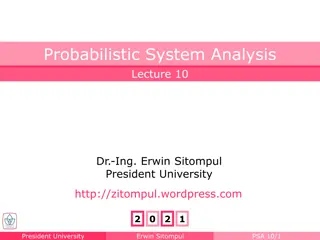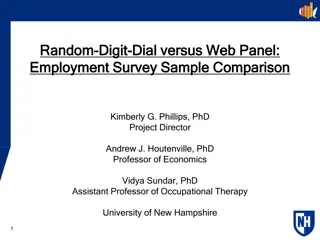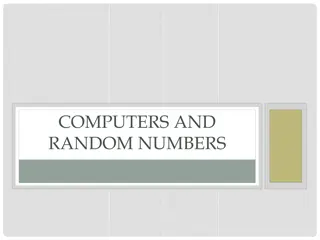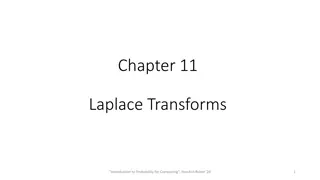Understanding Simple Random Samples in Statistics
In this lesson, you will learn how to obtain a simple random sample using slips of paper or technology, understand sampling variability and the impact of sample size, and use simulations to test claims about population proportions. The concept of Simple Random Sample (SRS) is explained, where every group of individuals in the population has an equal chance of being selected, ensuring each member has an equal chance of being chosen. Technology can be utilized to choose an SRS, especially for large populations, ensuring selections are made without replacement.
Download Presentation

Please find below an Image/Link to download the presentation.
The content on the website is provided AS IS for your information and personal use only. It may not be sold, licensed, or shared on other websites without obtaining consent from the author. Download presentation by click this link. If you encounter any issues during the download, it is possible that the publisher has removed the file from their server.
E N D
Presentation Transcript
Collecting Data Lesson 3.3 Simple Random Samples Statistics and Probability with Applications, 3rdEdition Starnes & Tabor Bedford Freeman Worth Publishers
Simple Random Samples Learning Targets After this lesson, you should be able to: Describe how to obtain a simple random sample using slips of paper or technology. Explain the concept of sampling variability and the effect of increasing sample size. Use simulation to test a claim about a population proportion. Statistics and Probability with Applications, 3rdEdition 2 2
Simple Random Samples In Lesson 3.2, you learned that choosing a sample at random is a good way to avoid bias. In this lesson, we start with the details of how to select a random sample. Simple Random Sample (SRS) A simple random sample (SRS) of size n is a sample chosen in such a way that every group of n individuals in the population has an equal chance of being selected as the sample. In an SRS, each sample of size n has the same chance to be chosen. This implies that each member of the population has the same chance of being chosen for the sample. Statistics and Probability with Applications, 3rdEdition 3 3
Simple Random Samples We can use technology to choose an SRS. This is especially helpful when the population is large. How to Choose an SRS with Technology Label. Give each individual in the population a distinct numerical label from 1 to N, where N is the number of individuals in the population. 1. Randomize. Use a random number generator to obtain n different integers from 1 to N. 2. Select. Choose the individuals that correspond to the randomly selected integers. 3. Statistics and Probability with Applications, 3rd Edition 4 4
Simple Random Samples When choosing an SRS, we make the selections without replacement. That is, once an individual is selected for a sample, that individual cannot be selected again. Most random number generators sample numbers with replacement, so it is important that you explain that repeated numbers should be ignored when using technology to select an SRS. There are many random number generators available on the Internet, including those at www.random.org. You can also use the random number generator on your calculator. Statistics and Probability with Applications, 3rd Edition 5 5
How safe are these trucks? How safe are these trucks? Selecting an SRS Selecting an SRS PROBLEM: A safety engineer at an automobile assembly plant knows that 180 pickup trucks will be assembled tomorrow. To meet federal regulations, the engineer must select 5 of those vehicles for safety testing. (a) Describe how to select an SRS of 5 trucks using slips of paper. Give each truck a distinct label from 1 to 180. Number 180 identically sized slips of paper from 1 to 180. Put these slips of paper into a hat and mix well. Select 5 slips of paper and test the 5 trucks that are labeled with the numbers selected to see if they meet federal regulations. (b) Describe how to select an SRS of 5 trucks using a random number generator. Give each truck a distinct label from 1 to 180. Randomly generate 5 integers from 1 to 180 ignoring repeated integers. Test the 5 trucks that are labeled with the generated integers to see if they meet federal regulations. Statistics and Probability with Applications, 3rd Edition 6 6
Simple Random Samples When Mr. McCourtney s class did the activity about the Federalist Papers, his students got the results shown below. Sampling Variability The fact that different random samples of the same size from the same population produce different estimates is called sampling variability. Statistics and Probability with Applications, 3rd Edition 7 7
Simple Random Samples Sample means vary, even though the samples are selected from the same population. We can reduce sampling variability by using a larger sample size. Statistics and Probability with Applications, 3rd Edition 8 8
Do I have to eat my veggies? Do I have to eat my veggies? Sampling variability Sampling variability PROBLEM: A recent Gallup poll found that 57.7% of a random sample of 1,947,144 Americans eat produce often. For the purposes of this poll, eating produce often is defined as eating the recommended daily allowance of fruits and vegetables at least 4 days in the previous week. http://www.gallup.com/poll/167738/fewer-americans-reported-healthy-eating- 2013.aspx (a) Do you think that the percentage of all Americans who eat produce often is equal to 57.7%? Explain. No. Because different random samples will produce different estimated percentages, it is unlikely that this particular sample provides a percentage that is exactly correct. (b) If the sample size was decreased to 10,000 Americans, what effect would this have on the estimated percentage of Americans who eat produce frequently? We would expect our estimate to be farther from the true percentage of Americans who eat produce regularly. Statistics and Probability with Applications, 3rd Edition 9 9
Simple Random Samples The purpose of a sample is to give us information about a larger population. The process of drawing conclusions about a population on the basis of sample data is called inference because we infer information about the population from what we know about the sample. Population Collect data from a representative Sample... Sample Make an Inference about the Population. Statistics and Probability with Applications, 3rd Edition 10 10
Do students prefer name-brand cookies? 1. The spinner is divided into two regions: 50% for the name-brand cookie and 50% for the store-brand cookie. Why do you think it was divided into two equal sections? To complete the spinner, get a small paper clip and unbend one end so that it has a loop at one end and a pointer at the other end. Place your pencil tip through the loop of the paper clip and put the tip of the pencil on the dot in the middle of the spinner. To simulate the preferences of a random sample of 30 students, spin the spinner 30 times and record how often it lands in the name-brand cookie region. Share your results with the class and make a class dotplot. Based on the dotplot, is there convincing evidence that the name- brand cookie is preferred? Or, is it plausible that the cookies are equally preferred at the school? Explain your reasoning. 2. 3. 4. 5. Statistics and Probability with Applications, 3rd Edition 11 11
Whats in a Stradivarius? What s in a Stradivarius? Testing a claim Testing a claim Old Italian violins, like those made by Antonio Stradivari, are supposed to have the best sound. Stradivarius violins are particularly prized and some have sold for more than $15 million. But could modern (new) instruments sound just as good? Researchers designed a study (http://www.pnas.org/content/111/20/7224.full#ref-5) in which 10 world- class violin soloists volunteered to play 12 different violins. Six of these violins were new and six were old, including a Stradivarius. The soloists wore modified welder s goggles, so that they couldn t visually identify any violins as new or old. After playing these instruments in a practice room, 9 of the 10 violinists identified a new violin as the one that they would choose as a replacement for their current instrument. To determine if these data provide convincing evidence that more than 50% of violin soloists would prefer a new violin to an old violin, 100 trials of a simulation were conducted. Each dot in the graph shows the number of violin soloists out of 10 who preferred a new violin, assuming each soloist had a 50% chance of choosing a new violin. Statistics and Probability with Applications, 3rd Edition 12 12
Whats in a Stradivarius? What s in a Stradivarius? Testing a claim Testing a claim (a) Explain how the graph illustrates the concept of sampling variability. If researchers repeatedly take random samples of size 10 from a population of violin soloists who show no preference for which violin they choose, the number of soloists in a sample who would choose a new violin varies from about 1 to 9. (b) Based on the results of the simulation, is there convincing evidence that violin soloists would have a greater preference for a new violin over an old one? Explain. Yes. In the study, there were 9 soloists who preferred a new violin. This is much higher than what we would expect to happen by chance alone. In the simulation, 9 soloists preferred a new violin only 1 time in 100, which is about 1% of the time in the long run. Statistics and Probability with Applications, 3rd Edition 13 13
Whats in a Stradivarius? What s in a Stradivarius? Testing a claim Testing a claim (c) The violinists were also given a second session in a large concert hall. This time, 6 of the 10 violinists identified a new violin as the one they would choose. Based on the results of the simulation, is there convincing evidence that violin soloists would have a greater preference for a new violin over an old one after the second session? Explain. No. In the study, there were 6 soloists who preferred a new violin after the second session. This is not much higher than what we would expect to happen by chance alone. In the simulation, 6 or more soloists preferred a new violin 35 times in 100, which is about 35% of the time in the long run. Statistics and Probability with Applications, 3rd Edition 14 14
LESSON APP 3.3 Do you tweet? What proportion of students at your school use Twitter? To find out, you decide to survey a simple random sample of students from your school. 1. Describe how you could select an SRS of 50 students. 2. Will your sample result be exactly the same as the true population proportion? Explain. 3. Which would be more likely to yield a sample result closer to the true population value: an SRS of 50 students or an SRS of 100 students? Explain. Statistics and Probability with Applications, 3rd Edition 15 15
LESSON APP 3.3 1. Describe how you could select an SRS of 50 students. Do you tweet? Statistics and Probability with Applications, 3rd Edition 16 16
LESSON APP 3.3 2. Will your sample result be exactly the same as the true population proportion? Explain. Do you tweet? 3. Which would be more likely to yield a sample result closer to the true population value: an SRS of 50 students or an SRS of 100 students? Explain. Statistics and Probability with Applications, 3rd Edition 17 17
Simple Random Samples Learning Targets After this lesson, you should be able to: Describe how to obtain a simple random sample using slips of paper or technology. Explain the concept of sampling variability and the effect of increasing sample size. Use simulation to test a claim about a population proportion. Statistics and Probability with Applications, 3rd Edition 18 18








